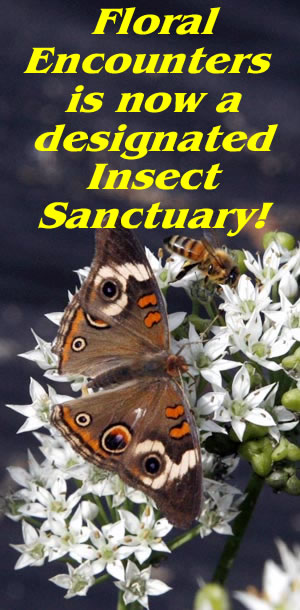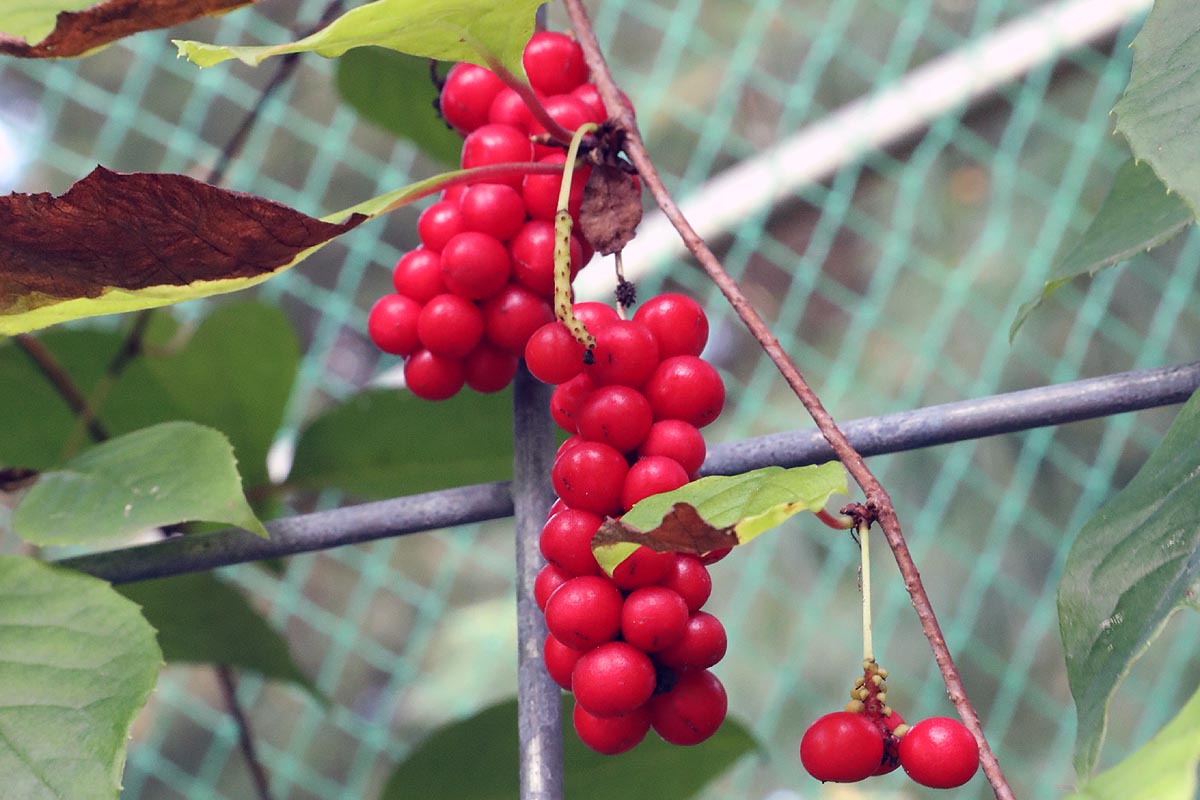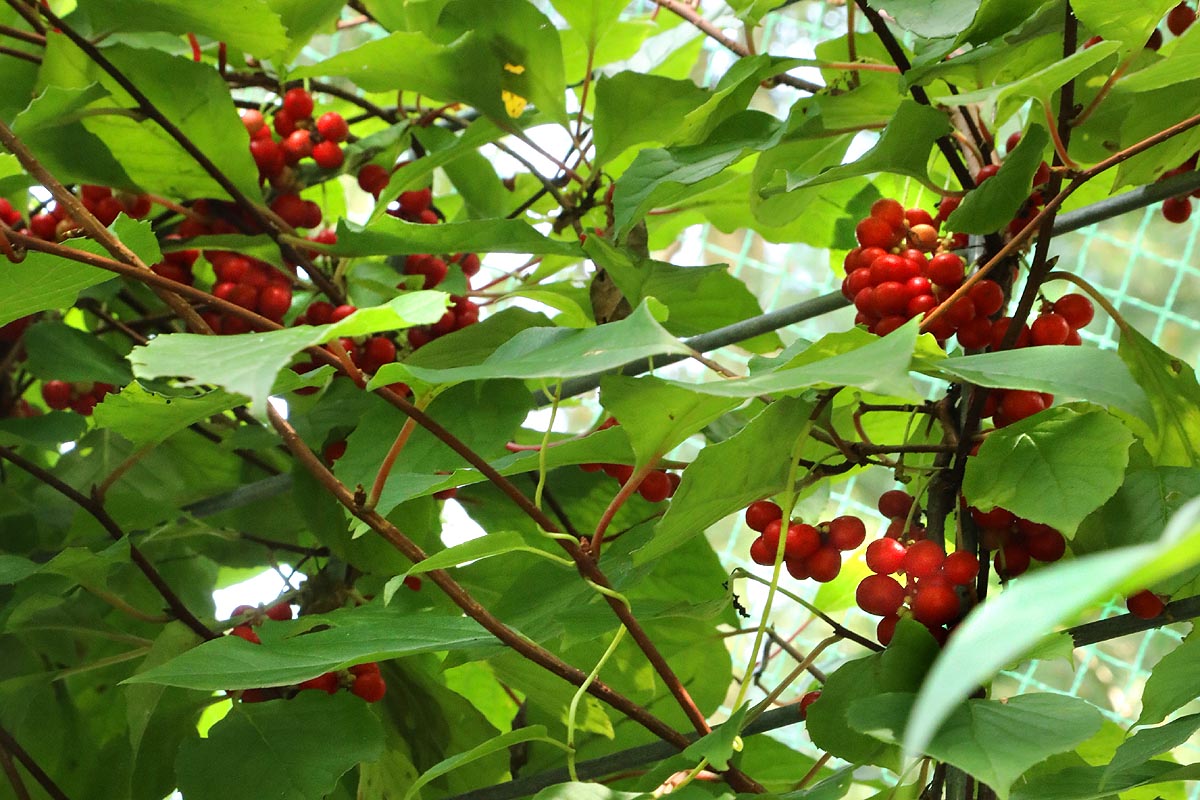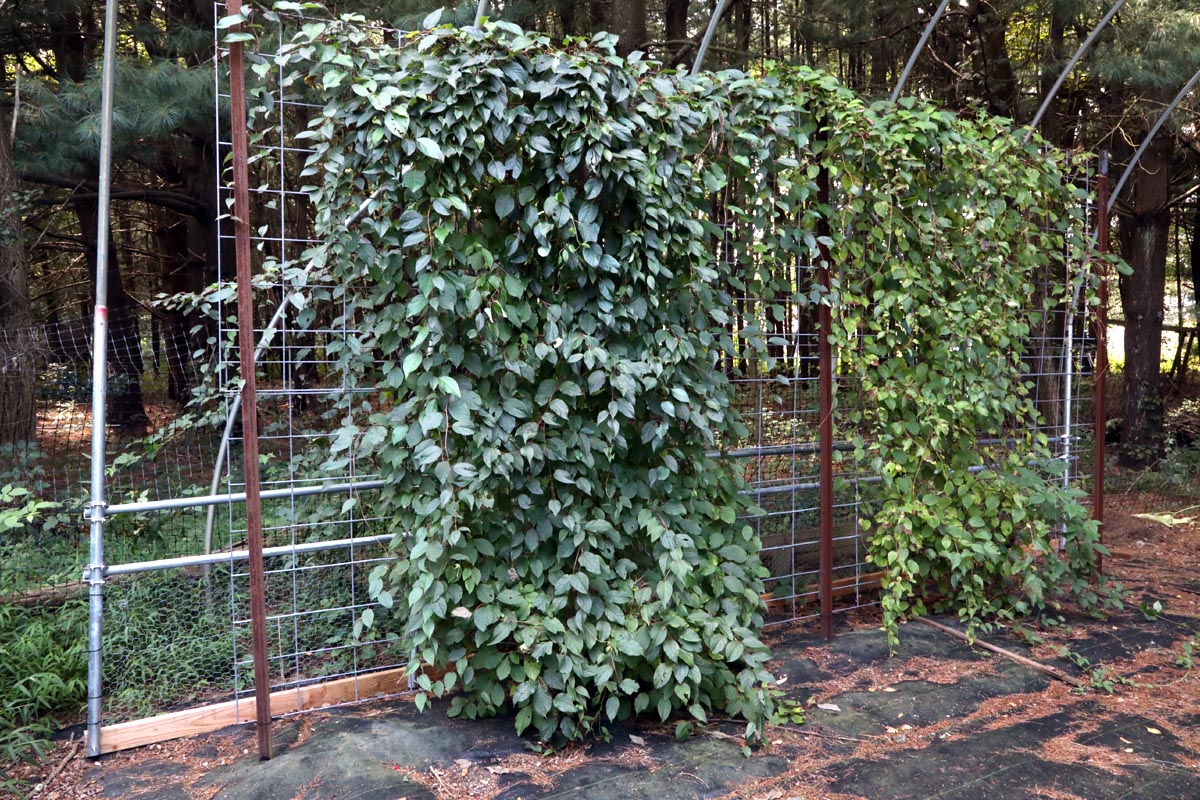This deciduous perennial vine is hardy to zone 4 and is grows vigorously if given something to climb. Makes a wonderful screen if trained on a trellis and in most zones its very happy in light shade to denser shade in the lower portions of its range (zones 7-8). The wide glossy dark green leaves mostly hide the lovely aromatic white flowers that bloom in late spring, but the aroma is very noticeable. The berries that follow the flowers are less easy to miss especially when they turn bright red and hang in clusters like miniature grapes. These edible berries have a flavour all their own which is described as a combination sweet, sour, bitter, salty and spicy. They have a wonderful aroma when crushed and have been used in Chinese medicine for centuries where it is known as Wu Wei Zi . It is considered to have very similar properties to ginseng, but is less expensive to grow. Growing does take a little more effort as the seeds are a bit fussy needing warm/cold cycles before they will germinate but they grow rapidly once started. Not a seed for the beginner but not an impossible challenge for more experience gardeners.
Before writing this description I took a look at what some other sources say and was confused by their descriptions. We have been growing Schisandra vines for many years now and very little of what I have observed seem to be correspond to what others are writing . It makes me wonder if they have ever seen a Schisandra vine in real life!
All our many vines flower and bear fruit. From what I can tell there are no male and female vines they all seem to have both sets of flowers. The leaves are not long and lancolate they are more rounded with a definite point and serrated edges. They are dark green and a little tough but no where near 'leathery' as many describe them.
Flowers grow on younger wood older vine does not produce flowers. We have also found that they only flower if allowed to climb. If left to sprawl on the ground flowers never form. The leaves of our plants never turn red, they just turn sort of brown and drop off. So far the birds have not found a taste for the berries.
Vines will sucker and produce new plants if they are not cut back. If care is not taken they will form thickets.
Once seeds arrive place them in the refridgerator until ready to begin the process. If the temperatures are mild when you ordered your seeds we recommend you begin this process as soon as possible. If its has been cold weather the whole time they will still be in cold dormant mode.
Soak seeds in warm, not hot water for 24 hours. This allows the seeds to swell and get used to warmer temperatures.
While this is happening prepare the growth medium. We strongly recommend using sterile germination mix or sterile sand or sandy soil. Do not use soil from your garden unless it has been processed first. See our 'Making sterile soil' instructions.
Choose a receptacle to place your seeds in this can be a plastic ziplock bag or small pots. Whatever you choose it will need to be placed in your refridgerator at some point so consider carefully. Because of this we recommend using egg boxes.
Use clean disposable plastic gloves to ensure your body does not contaminate the soil with any spores or bacteria that lives on our skin. If at all possible do this during the winter or early spring when mold spores are that their lowest.
Fill the dimples in the egg box with sterile medium about 3/4 of the way up the dimple. Place the seeds 1-2 in each and cover with more medium moisten it. It should not be wet just moist. LABEL THE BOX and date it. Wrap the box in a clear plastic bag and seal it shut. Place box somewhere in your house that is warm but not hot. A cupboard or draw is ideal it does not need light. Leave it there for a month (30 days)
After the warm period is over, check to ensure its still moist and no mold has formed. This should not occur if the medium was sterile and no spores fell on it while you were seeding. If it needs more water add a little do not over moisten the medium or the seeds may rot.
Take the box and place it in the refrigerator. Somewhere at the back where it wont get disturbed or tossed around. Make sure you keep it upright. Leave it there for 30 days.
At the end of this time bring it out and open it. Place in light warm location and keep moist. If desired each dimple can be scooped out an placed in a larger pot at this stage. This helps to keep the medium moist as it dries out very fast in small egg dimples.
Seeds usually germinate in about 30-40 days. However some may be more stubborn. Place such pots in a semi shaded location and keep watered throughout the year. If they still have not germinated by time winter returns bury them up to within an inch of the pot top and cover with mulch until spring comes. Most remaining seeds will usually germinate the second spring.
Likes well drained soil and good organic material for best growth. Can tolerate most soils if well drained cannot tolerate wet soils or those that dont drain reasonably quickly. Needs regular watering if berries are desired does not tolerate drought well. May need cutting back to save the core plant if water cannot be offered during heavy drought.
Needs to be trellised. While vines will sprawl across the ground they rarely flower. Offer trellis as high as you are willing to reach on a step ladder the vines will climb it. Pick a heavy metal trellis for best results and easy of berry picking. We find cattle panels are ideal.
Pruning. Best done in early spring before the leaves appear. Blooms on newer stems so cut vines back to allow the new vigorous grow to spread across the trellis. if watered and fed well they will grow several feet in a year, bloom and produce fruit.
Mulch in summer or fall ready for spring and liquid feed during the summer as the fruits are swelling for best results. Remove or pull up suckers if spreading is undesirable or move rooted suckers to new spot and use for a new plant. Plant at least 10 feet apart. These vines get large.
Trellised vines make an excellent screen even in winter the many small thin vines make a good privacy screen.
While some report that birds eat the berries ours have yet to acquire a taste for the spicy berries but planning for a method to protect your crop from birds is prudent.
Research has been conducted using this herb and fond that it can be effective in protecting the liver from some toxins and treating some liver disorders including hepatitis, with no side effects.. It was also found to be effective after myocardial infarction and overall helped increase endurance and metabolism, improved cognitive function.








